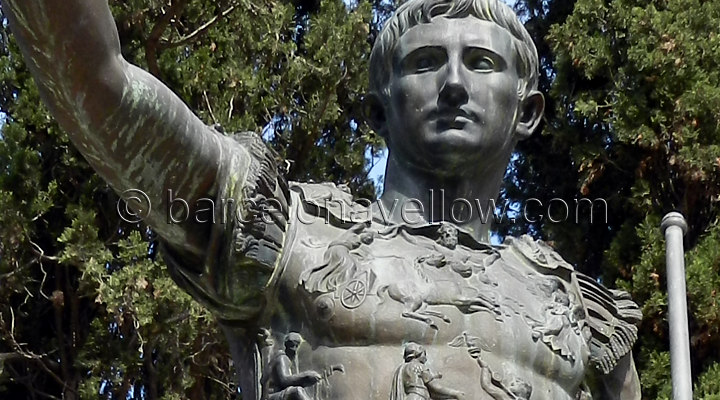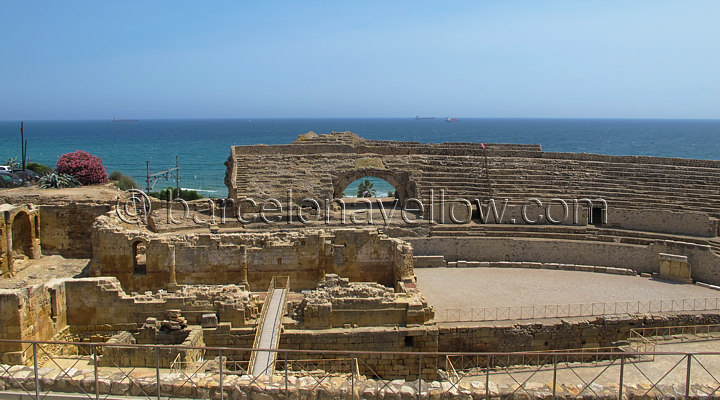| HOME |
| Hotels |
| Apartments |
| Attractions |
| Restaurants |
| Tickets & tours shop |
| Tours |
| Maps & travel planners |
| Airports & transport |
| Maps |
| Events |
| Shopping |
| Contact us |
|
| Biography of Caesar Augustus and his relationship with Tarragona |
Biography of Caesar Augustusand his relationship with Tarragona, SpainTarragona tourist office Day tours Tarragona Roman ruins Tarragona shore excursion  Above sculpture Caesar Augustus in Tarragona Born Gaius Octavius Thurinus on September 23, 63 BCE, in Rome, Caesar Augustus, originally known as Octavian, emerged as one of the most influential figures in Roman history. As the grandnephew and adopted son of Julius Caesar, he navigated the turbulent aftermath of Caesar's assassination, showcasing remarkable political acumen and strategic prowess. At the age of 18, Octavian formed the Second Triumvirate, marking the beginning of a transformative era for Rome. The decisive Battle of Actium in 31 BCE secured his dominance over rivals Mark Antony and Cleopatra, leading to the establishment of the Roman Principate. As the first Emperor of Rome, Caesar Augustus skillfully consolidated power while maintaining the facade of a restored Republic. His rule, known as the Pax Romana, ushered in a period of relative peace and prosperity lasting for two centuries. Augustus implemented key political and social reforms, fostering stability and cultural flourishing. His legacy endures not only as a shrewd political strategist but also as a patron of the arts, contributing to the architectural and literary achievements of the Golden Age of Latin literature. Despite the complexities of his reign, Caesar Augustus remains a central figure in shaping the Roman Empire's destiny. His leadership, marked by a delicate balance of authority and subtlety, solidified his place as the founder of an imperial system that would leave an indelible mark on the course of Western history. August month named after AugustusThe month of August is named after the Augustus Caesar. Originally, this month was called "Sextilis" in Latin, meaning the sixth month. However, when the Roman Senate honored Augustus Caesar with the title "Augustus" in 8 BCE, following his victories and achievements, they decided to rename Sextilis in his honor. Augustus, whose birth month was September, felt that he should not have a month named after him that was inferior to Julius Caesar's month, July. Therefore, Augustus requested that Sextilis be given 31 days, just like July, and that the month of July should not be longer than his. This adjustment was made, and the month of Sextilis became known as August. So, the name "August" is a result of the homage paid to the Roman Emperor Augustus, reflecting the significance of his contributions and accomplishments during his rule. Augustus and TarragonaTarraco, as it was called in Roman times, held a special status during the reign of Augustus. It was designated as one of the key administrative centers in the Iberian Peninsula and became the capital of the Roman province of Hispania Citerior. Tarraco was the principal colony of Hispania Citerior, the “near” portion of the Iberian Peninsula. The settlement hosted a number of famous commanders such as Pompey and Julius Caesar, but didn't become a major city until the reign of Augustus Augustus initiated various infrastructure projects in Tarraco, contributing to the city's development and prosperity. The remains of a Roman aqueduct, a quarry, walls, an amphitheatre, and a circus that can still be seen today are a testament to the Roman influence on the city during this period. These structures were part of the grandeur that characterized Tarraco as a prominent Roman urban center. The relationship between Caesar Augustus and Tarragona, therefore, was one of imperial governance and strategic importance. Augustus recognized the strategic value of Tarraco as a hub for controlling the Iberian Peninsula and enhancing Roman influence in the region. His contributions to the city's infrastructure and development reflected the broader efforts to consolidate and strengthen the Roman presence in the western Mediterranean. Augustus wintered at Tarraco after his Cantabrian campaign, and bestowed many marks of honour on the city, among which were its honorary titles of Colonia Victrix Togata and Colonia Julia Victrix Tarraconensis. The Roman ruins of Tarraco are now a UNESCO World Heritage Site. Below: Amphitheatre of Tarragona is on the coast of the Mediterranean Sea by Platja del Miracle beach.  Related pages: Tarragona tourist office Day tours to Tarragona Roman ruins How to get to Tarragona © Copyright Barcelonayellow.com. Do not copy from this page without permission All rights reserved |
| Last Updated on Thursday, 13 February 2025 13:12 |
|
|
Tuesday, 16 September 2025

Barcelona Spain - Barcelona Travel Guide - Copyright 2007-2025
Privacy Policy and Cookies • Legal Disclaimer • Copyright
BarcelonaYellow SiteMap 2025
Barcelona Latest News:
COVID-19 - Barcelona Latest News
Barcelona Safety Guide 2025
Barcelona Top 10 attractions 20254
Plan 3 days in Barcelona 2025
About us
About us
Contact us
Privacy Policy and Cookies
Copyright notice
Legal disclaimer
Twitter Barcelona events
Partnerships
Advertising
COVID-19 - Barcelona Latest News
Barcelona Safety Guide 2025
Barcelona Top 10 attractions 20254
Plan 3 days in Barcelona 2025
About us
About us
Contact us
Privacy Policy and Cookies
Copyright notice
Legal disclaimer
Twitter Barcelona events
Partnerships
Advertising
Accommodation
Hotels in Barcelona
Hotels near Fira Exhibition
Hotels near Camp Nou
Hotels near Cruise Ships
Short Stay Apartments
Practical information
Useful visitor information
How to get to Barcelona airport
Cruise Ship Terminals
Barcelona maps
Airport buses
Barcelona metro
Taxis
Travel cards
Hotels in Barcelona
Hotels near Fira Exhibition
Hotels near Camp Nou
Hotels near Cruise Ships
Short Stay Apartments
Practical information
Useful visitor information
How to get to Barcelona airport
Cruise Ship Terminals
Barcelona maps
Airport buses
Barcelona metro
Taxis
Travel cards
Things to do
Top 10 attractions Barcelona
Photos of Barcelona
Restaurant Guide
Nightlife Guide
Things to do in Barcelona
Barcelona beaches
Book tours and tickets
Skiing near Barcelona
Weather Barcelona
Weather in Barcelona
5 day forecast Barcelona
Top 10 attractions Barcelona
Photos of Barcelona
Restaurant Guide
Nightlife Guide
Things to do in Barcelona
Barcelona beaches
Book tours and tickets
Skiing near Barcelona
Weather Barcelona
Weather in Barcelona
5 day forecast Barcelona
Top Festivals and events
Barcelona Events 2025
Christmas in Barcelona
New Years Eve 2025
MWC 2025 Barcelona
Sant Jordi's Day
Barcelona Marathon
Barcelona Half Marathon
Easter
Festa de Gracia
La Merce Festival
FC Barcelona calendar
Barcelona Events 2025
Christmas in Barcelona
New Years Eve 2025
MWC 2025 Barcelona
Sant Jordi's Day
Barcelona Marathon
Barcelona Half Marathon
Easter
Festa de Gracia
La Merce Festival
FC Barcelona calendar
Moving to Barcelona
Moving to Barcelona
Long term apartment rentals
Relocation agencies
Real estate agencies
Spanish schools
Meeting people
Finding work
Yellow pages directory
Partner websites:
DayTripsBarcelona.com
Stepbac.com
PhotoMemoirs.co
Helpfurl.com
Moving to Barcelona
Long term apartment rentals
Relocation agencies
Real estate agencies
Spanish schools
Meeting people
Finding work
Yellow pages directory
Partner websites:
DayTripsBarcelona.com
Stepbac.com
PhotoMemoirs.co
Helpfurl.com
